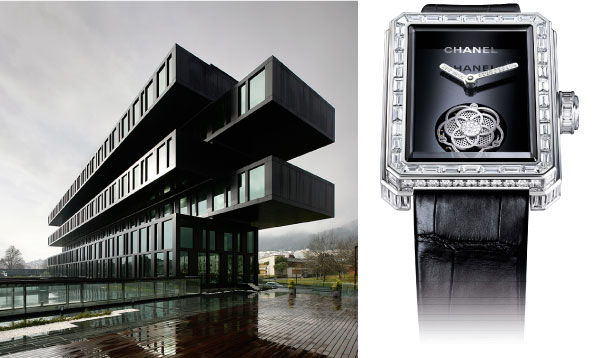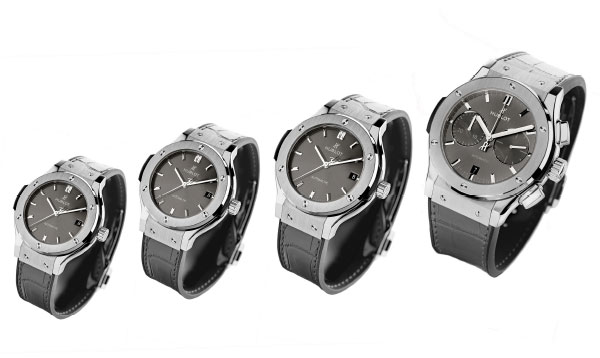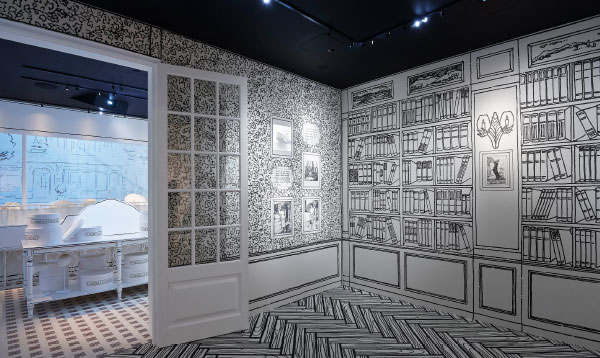
Première Tourbillon Volant
Case : white gold set with 228 diamonds (7.7 carats) Size : 28.5 x 37mm Movement : mechanical hand-wound (Caméllia calibre by Renaud & Papi, 40h power reserve) on custom-made rectangular baseplate, with flying tourbillon (73 parts) and variable-inertia balance, high-end watchmaking finishing Functions : hours, minutes, small seconds on the tourbillon carriage Dial : polished black ceramic Water resistant : 30m Strap : black alligator leather or satin with white gold folding clasp set with 30 diamonds Limited edition : 20 numbered watches
Big Bang Aero Bang Niemeyer
Case : microblasted tantalum, black PVD-coated titanium crown and pushers with black rubber insert, sapphire crystal caseback with transferred depiction of the Square of the Three Powers Size : 44mm Movement : mechanical self-winding (HUB Calibre 4214, 42h power reserve), black PVD-coated cut-out oscillating weight, tungsten segment, microblasted black chrome plate matt black, skeletonised Water resistance : 100m Strap : adjustable, in black rubber and black Porosus Hornback crocodile leather with grey stitching, black PVD-coated steel Big Bang folding clasp
Chanel Tourbillon Volant
Stylised as a camellia with a diamond-pavé heart featuring petals indicating the seconds by rotating once a minute, Chanel’s first flying tourbillon celebrates the 25th anniversary of the brand’s first watch creation. Its movement was made in cooperation with the experts at Renaud & Papi, mounted on a tailor-made rectangular baseplate and meticulously decorated. The famous N°5 fragrance with its octagonal-shaped bottle-stopper inspired the shape of its white gold case set with 101 baguette-cut diamonds and 127 brilliant-cut diamonds (totalling 7.7 carats). Its sparkling contours and its brilliant three-dimensional micromechanical assembly make a striking contrast with its polished black ceramic dial swept over by offset, gem-set hands. Only 20 lucky women will be fortunate enough to acquire a piece in this limited series.
Its architectural counterpart : the Axis Viana hotel
Designed by VHM Architecture, the Axis Viana hotel is located at Viana do Castello in Portugal. The hotel complex is built on the site of a former bus station, spread along the site access route and surrounded with low-scale residential buildings. Within this context, the main structure stands out by its elongated geometrical appearance featuring several stacked rectangular prisms. The superimposition of several glass and aluminium containers divides the building into compartments and segments its volume. The architects have conceived this assembly of parts much like a Lego-type construction game, and have taken this reasoning to extremes. Implementing this approach based on cantilevered volumes involved a considerable technical feat and a strong accentuation of the superimposition principle, since the levels of the various floors composing this construction are individualised and these accommodation areas are each distinct and not simply positioned directly on top of each other.
This stage-setting highlights the receptacles and the positioning of the guests’ rooms, all the same sizes and designed as “boxes” signalling the presence of a hotel facility in this place and demonstrating that the customary stacked arrangement of the rooms may be reinterpreted. There is a certain amount of intriguing ambiguity in the architects’ approach to the shape of this building.
It represents in some way a propensity to modify the appearance of an object, to blur the customary meanings of things and to infuse them with a deliberate degree of complexity. This attitude bars certain similarities to that we have glimpsed with the Chanel watch and the sophisticated design of its case.

Hublot
Hublot Big Bang “Aero Bang Niemeyer”
A watch created in tribute to one of the greatest 20th century
architects was bound to find its place in our Architecture column. Hublot has indeed chosen to dedicate a 104-piece Aero Bang limited series in tantalum to the 104th anniversary of Oscar Niemeyer, a Brazilian architect who designed over 600 projects, including the United Nations headquarters. The main reason for this endeavour lies in its role in creating Brasilia, the futuristic city symbolising modern Brazil and which is to host the football World Cup in 2014, at which Hublot will serve as official timekeeper. The colours of Brasilia are echoed on the yellow and green hour-markers and hands, while the sapphire crystal fitted into the microblasted titanium caseback bears a depiction of the Place des Trois Pouvoirs, one of the legendary works by the great architect born over a century ago. The customary “organised
destructuration” design of the openworked dial and the composite lateral inserts remain loyal to identity codes of the Big Bang range, also recognisable in the rubber crown inserts and the titanium pushpieces. From a strictly functional standpoint, this automatic chronograph with date display has a 42-hour power reserve and is water-resistant to 100 metres.
Its architectural counterpart : El Mirador, Madrid
En Pau Sanchinarro is an area on the outskirts of the city of Madrid tucked into the middle of a highway network, which for some time has been undergoing a major transformation, with increasing development of construction on the land. Amongst the other operations already envisaged in this area, the “El Mirador de Sanchinarro” building was designed by Dutch architects, MVRDV and Blanca Lleò. Built on two plots of land, the building consists of 22 floors and its presence stands out amid the surrounding countryside. The interior living areas are set on either side of a rooftop summerhouse, which, some 40 meters above the ground, comprises a communal garden and provides a view over the city. The apartments incorporated into this construction are varied and arranged in small “blocks”. These are different dwelling units that are either placed one on top of the other or juxtaposed, and are highlighted by the signs on the front.
This stage-setting effectively distracts observers’ attention because, through this optical trick, the imposing mass of this construction disappears, leaving a more fragmented perception of the object in question – and the coloured parts of the edifice appear more as the independent shapes and parts of a collage.
This visual particularity helps us see the likeness to the impression that we get from the Hublot watch. In much the same way, intelligent manipulation and diversion of the gaze actually modifies the meaning of objects and, through the many different pieces of information supplied, creates the feeling that these actually involve greater complexity of use.






